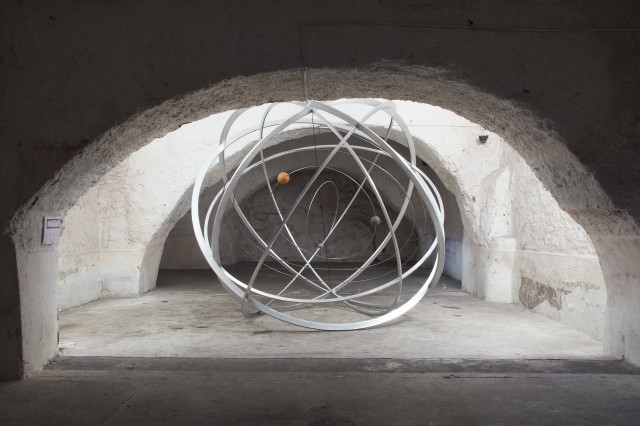Featuring new solo projects by Christian Waldvogel (Zurich) and Eric Wesley (Los Angeles), Fondazione Donnaregina per le arti contemporanee and Fondazione Morra Greco are proud to present the second installment of a series of exhibitions entitled Hybrid Naples: L’ordine delle idee deve procedere secondo l’ordine delle cose, part of the Progetto XXI exhibition project.
Waldvogel, in homage to the great philosopher Giordano Bruno who studied in Naples, will present a machine producing planets; and Wesley will exhibit a full knight’s suit of armor built accurately to his idiosyncratic specifications. Thus, both projects lend the project not only a pronouncedly historical perspective in a city marked by 3000 years of cultural confluence, but actually expose the dramatic fluctuation between seemingly separate times and places, historical and contemporary things.
The main title of the series reflects on the city of Naples as a continuously rebuilt monument to hybridity. “The open city feels like Naples, the closed city feels like Frankfurt”, wrote Richard Sennett in 2006. Naples here is understood as a city remaining adaptable by improvisation, accommodating diversity and dissonance (for better or worse) rather than over-determined homogenization. But rather than just a current state of things, the idea of an “open”, hybrid Naples also implies three millennia of history: of a place where Greek, Etruscan, Roman, Spanish, German, Dutch, and many other presences have left their mark.
As a cultural reality and technique, hybridity – the crossing and intermingling of different cultural influences and elements – has become a factor dramatically accelerated by contemporary technological environments, from the importance of Social Media to artists using affordable digital technology. It directly affects what today we understand as being contemporary art: potentially, anything. However, this broadness of possible methods and motifs for current artists should not be understood as randomness. This is what the subtitle of the show is meant to remind of: ‘the order of ideas must follow the order of things’. It is a quote bythe great Neapolitan philosopher Giambattista Vico (1668–1744). It stems from his famous main work Scienza Nuova(New Science, 1725), in which he argues that civilization develops in recurring cycles. This axiom “the order of ideas must follow the order of things” asks us to consider that the shared experience of the conditions under which we live gives rise to shared ideas – rather than the other way round (an anticipation of Karl Marx’ famous “being determines consciousness”).
Taking this thought as a cue for the exhibition, it means that the artist’s experience and its reflection in their internal thought processes will give rise to the ideas expressed in their respective projects – rather then these ideas being randomly preconceived products ‘parachuted in’, or merely being the outcome of prescriptive instructions bya curator demanding illustrations of hybridity or any such thing.
(Text by Anna Cuomo)
